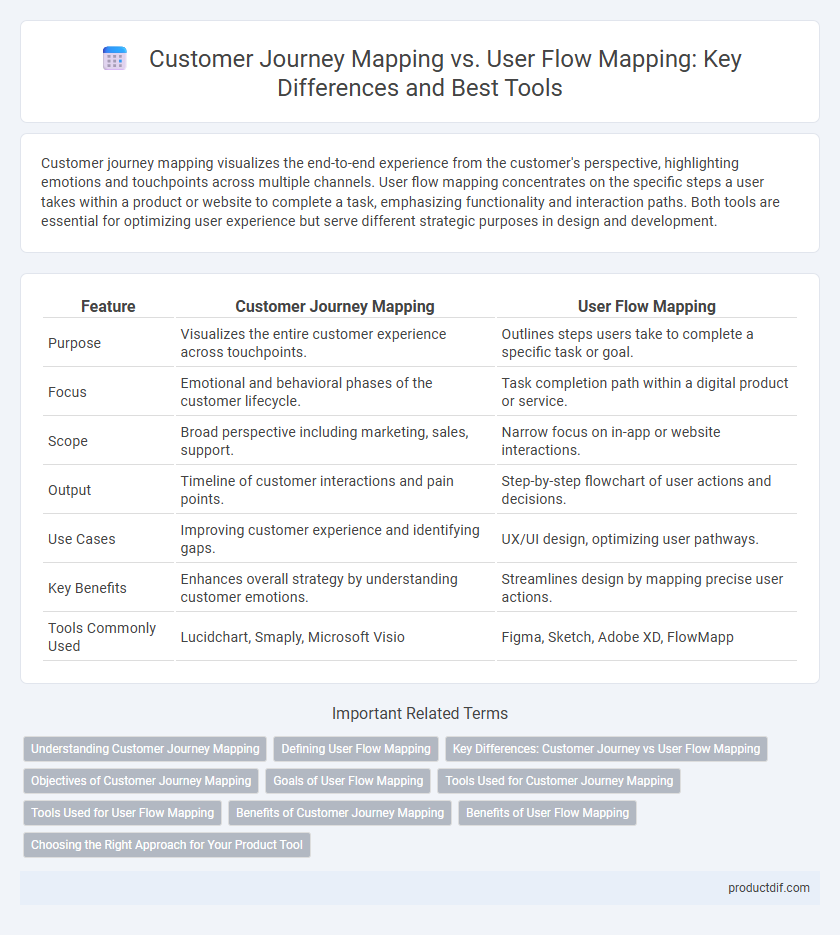Customer journey mapping visualizes the end-to-end experience from the customer's perspective, highlighting emotions and touchpoints across multiple channels. User flow mapping concentrates on the specific steps a user takes within a product or website to complete a task, emphasizing functionality and interaction paths. Both tools are essential for optimizing user experience but serve different strategic purposes in design and development.
Table of Comparison
| Feature | Customer Journey Mapping | User Flow Mapping |
|---|---|---|
| Purpose | Visualizes the entire customer experience across touchpoints. | Outlines steps users take to complete a specific task or goal. |
| Focus | Emotional and behavioral phases of the customer lifecycle. | Task completion path within a digital product or service. |
| Scope | Broad perspective including marketing, sales, support. | Narrow focus on in-app or website interactions. |
| Output | Timeline of customer interactions and pain points. | Step-by-step flowchart of user actions and decisions. |
| Use Cases | Improving customer experience and identifying gaps. | UX/UI design, optimizing user pathways. |
| Key Benefits | Enhances overall strategy by understanding customer emotions. | Streamlines design by mapping precise user actions. |
| Tools Commonly Used | Lucidchart, Smaply, Microsoft Visio | Figma, Sketch, Adobe XD, FlowMapp |
Understanding Customer Journey Mapping
Customer journey mapping visualizes the entire experience a customer has with a brand, highlighting touchpoints, emotions, and pain points throughout the buying process. It captures customer motivations and behaviors across multiple channels to identify opportunities for improving satisfaction and loyalty. Understanding customer journey mapping enables businesses to align marketing, sales, and support efforts by addressing real customer needs and expectations effectively.
Defining User Flow Mapping
User flow mapping is a visual representation of the specific steps a user takes to complete a task within a product or website, emphasizing the sequence of actions and decision points. It helps designers identify friction points and optimize navigation to enhance user experience by focusing on task completion efficiency. This method contrasts customer journey mapping by concentrating on detailed in-app or on-site behaviors rather than broader emotional or experiential phases.
Key Differences: Customer Journey vs User Flow Mapping
Customer journey mapping outlines the entire user experience across multiple touchpoints and channels, emphasizing emotional stages and long-term engagement, while user flow mapping focuses on the specific steps a user takes within a digital product to achieve a goal. Customer journey maps capture broader interactions, including offline and cross-channel behaviors, whereas user flows detail product-specific navigation paths, highlighting decision points and actions. These distinctions make customer journey mapping ideal for strategic marketing and service design, and user flow mapping crucial for UX design and interface optimization.
Objectives of Customer Journey Mapping
Customer journey mapping focuses on understanding the entire customer experience by visualizing touchpoints, emotions, and pain points across all channels to enhance satisfaction and loyalty. Its primary objective is to identify opportunities for improving customer engagement by aligning business strategies with customer needs. This holistic approach enables organizations to optimize interactions and drive meaningful, long-term relationships.
Goals of User Flow Mapping
User flow mapping focuses on optimizing the steps users take to complete specific tasks, enhancing usability and reducing friction points in the process. It aims to clearly define each interaction point, ensuring seamless navigation and boosting conversion rates. This method is essential for identifying pain points and streamlining digital experiences to meet user expectations efficiently.
Tools Used for Customer Journey Mapping
Customer journey mapping tools such as Smaply, Custellence, and Touchpoint Dashboard enable businesses to visualize customer experiences across multiple touchpoints for improved engagement. These tools offer features like persona creation, journey stage visualization, and emotion tracking, facilitating comprehensive insight into customer behavior. Integration with CRM systems and analytics platforms enhances data-driven decision-making and optimizes marketing strategies.
Tools Used for User Flow Mapping
User flow mapping tools like Figma, Sketch, and Adobe XD offer interactive prototyping and real-time collaboration, enhancing the design process. FlowMapp and Overflow specialize in visualizing user flows with intuitive drag-and-drop interfaces and integration capabilities for seamless team communication. These tools prioritize usability analysis, helping designers optimize navigation paths and improve overall user experience.
Benefits of Customer Journey Mapping
Customer journey mapping provides a holistic view of the entire customer experience across multiple touchpoints, enabling businesses to identify pain points and opportunities for improvement. It fosters empathy by visualizing customer emotions and behaviors, which helps tailor marketing, sales, and support strategies to enhance overall satisfaction. This comprehensive insight drives strategic decision-making and alignment across teams, ultimately boosting customer retention and lifetime value.
Benefits of User Flow Mapping
User flow mapping provides clear visualization of each step users take to achieve specific goals, improving interface design and reducing friction points. This tool enhances user experience by identifying navigation paths and optimizing task completion rates, leading to increased engagement and satisfaction. Data-driven insights from user flow mapping support targeted improvements, resulting in streamlined workflows and higher conversion rates.
Choosing the Right Approach for Your Product Tool
Customer journey mapping captures the entire customer experience across multiple touchpoints, providing insights into emotional drivers and pain points, ideal for strategic planning in product development. User flow mapping focuses on the step-by-step actions users take within a product, optimizing usability and interaction design for specific features. Selecting between these approaches depends on whether the goal is to understand overall customer behavior or streamline in-product navigation and task completion.
Customer journey mapping vs User flow mapping Infographic

 productdif.com
productdif.com